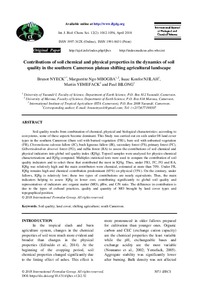| dc.contributor.author | Nyeck, B. |
| dc.contributor.author | Mbogba, M.N. |
| dc.contributor.author | Njilah, I.K. |
| dc.contributor.author | Yemefack, M. |
| dc.contributor.author | Bilong, P. |
| dc.date.accessioned | 2019-12-04T11:24:30Z |
| dc.date.available | 2019-12-04T11:24:30Z |
| dc.date.issued | 2018-04 |
| dc.identifier.citation | Nyeck, B., Mbogba, M.N., Njilah, I.K., Yemefack, M. & Bilong, P. (2018). Contributions of soil chemical and physical properties in the dynamics of soil quality in the southern Cameroon plateau shifting agricultural landscape. International Journal of Biological and Chemical Sciences, 12(2), 1042-1056. |
| dc.identifier.issn | 1991-8631 |
| dc.identifier.uri | https://hdl.handle.net/20.500.12478/4384 |
| dc.description.abstract | Soil quality results from combination of chemical, physical and biological characteristics; according to ecosystems, some of these aspects become dominant. This Study was carried out on soils under 08 land cover types in the southern Cameroon ((bare soil with burned vegetation (FR1), bare soil with unburned vegetation (FR), Chromolaena odorata fallow (JC), bush ligneous fallow (JR), secondary forest (FS), primary forest (FC), Gilbertiodendron dewevei forest (FG), and raffia forest (RA) to assess the contributions of soil chemical and physical indicators into global soil quality index (IQSg). Topsoil samples were analyzed for physico-chemical characterizations and IQSg computed. Multiples statistical tests were used to compare the contribution of soil quality indicators and to select those that contributed the most in IQSg. Thus, under FR1, FC, FG and RA, IQSg was relatively high and the main contributors were chemical, estimated at more than 70%. Under FR, IQSg remains high and chemical contribution predominant (65%) on physical (35%). On the contrary, under fallows, IQSg is relatively low; these two types of contributions are nearly equivalents. Thus, the main indicators helping to assess IQSg in lower cost, contributing significantly to global soil quality and representatives of indicators are: organic matter (MO), pHw, and C/N ratio. The difference in contribution is due to the types of cultural practices, quality and quantity of MO brought by land cover types and topographical position. |
| dc.format.extent | 1042-1056 |
| dc.language.iso | en |
| dc.subject | Soil |
| dc.subject | Land Cover |
| dc.subject | Shifting Cultivation |
| dc.subject | Fallow |
| dc.subject | Soil Chemicophysical Properties |
| dc.title | Contributions of soil chemical and physical properties in the dynamics of soil quality in the southern Cameroon plateau shifting agricultural landscape |
| dc.type | Journal Article |
| dc.description.version | Peer Review |
| cg.contributor.affiliation | University of Yaoundé |
| cg.contributor.affiliation | University of Maroua, Cameroon |
| cg.contributor.affiliation | International Institute of Tropical Agriculture |
| cg.coverage.region | Africa |
| cg.coverage.region | Central Africa |
| cg.coverage.country | Cameroon |
| cg.creator.identifier | Martin YEMEFACK: 0000-0002-6709-8503 |
| cg.authorship.types | CGIAR and developing country institute |
| cg.iitasubject | Soil Fertility |
| cg.iitasubject | Soil Health |
| cg.journal | International Journal of Biological and Chemical Sciences |
| cg.howpublished | Formally Published |
| cg.accessibilitystatus | Limited Access |
| local.dspaceid | 100624 |
| cg.targetaudience | Scientists |
| cg.identifier.doi | https://dx.doi.org/10.1016/j.aoas.2018.05.006 |

